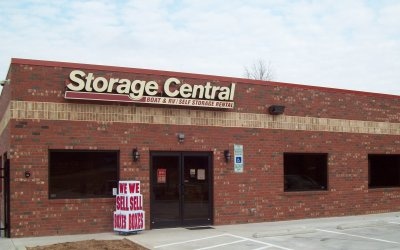The developers of Storage Central in Raleigh-Cary, N.C., had to overcome adversity and wade through challenges, particularly with the city, to reach completion.
April 28, 2011

By John Carlisle
According to 2010 U.S. Census data, the Raleigh-Cary, N.C., metropolitan area ranked first among the 50 largest in the country for growth over the past 10 years. The city of Raleigh proper swelled to a population of more than 400,000. Similarly, CNN Money reported Raleigh-area homebuilding remained strong, with a 16 percent growth in new permits in 2010an anomaly to the nationwide downturn in construction and real estate. Add all these factors to the large nearby Falls Lake and Jordan Lake, and metro Raleigh seems like a great place for a new self-storage venture, especially one offering boat and RV storage.
Enter Storage Central. Now open on the eastern fringe of Raleigh, the facility is next to a major highway (U.S. 264) and just east of Interstate 440, locally known as the beltline. Its in the middle of the regions suburban development, providing a solid base for potential self-storage customers.
The 58,000-square-foot facility features 112 climate-controlled units, 37 traditional units, and 22 fully enclosed and 12 partially enclosed boat- and RV-storage spaces. After a planned second phase of expansion, the facility will grow to more than 150,000 square feet. But this construction success isnt without a back story of overcoming adversity and wading through challenges, particularly with city approvals.
Conquering Challenges
Site planning began in early 2008 by Sam Sabri, CEO of BETCO Inc., a manufacturer of metal self-storage buildings and components, and Steve Gray, president of Colfax, N.C.-based Gray Building and Construction, a real estate developer and builder. Though the area they were building was already zoned to allow self-storage, Gray had enough experience to know that few building plans are executed without hiccups.
The first hurdle was somewhat expected and came early in the process, as the city denied a permit to build a sewer-dump station. With RV storage integral to the business plan, a sewer-dump station was crucial if the facility wanted to cater to RV customers. After meeting with our engineers and the city of Raleigh's utility director, we were able to work out a plan to satisfy the city and still meet our own criteria, Gray explains.
The next challenge was a complete curveball. As Gray and his team were tracking approvals, they came within one signature of sewing up all their plans. Then came the news. The city unexpectedly decided to re-classify one of our buildings as an indoor-parking garage, Gray says.
The parking-garage designation was saddled to the fully enclosed boat- and RV-storage spaces. The designation triggered two necessary but costly and structurally challenging changes to the design. First, the building would need a sprinkler systemincluding the associated infrastructurefor fire safety. Second, an exhaust-ventilation system would have to circulate air in and out of each unit in the building.
The exhaust system standards we were required to install are not generic by nature, Gray explains. Therefore, we had to custom-design the system to specifically meet our needs.
Another challenge was the 22,000-square-foot retention pond, designed with an underground drainage system, covered by Bermuda sod and made from a specially blended mix of soil that filters and cleans water. Funding the pond and keeping it in line with regulations proved expensive.
The [cost of] the pond itself is all in addition to the nutrient buy down fees imposed by the government, Gray says. We probably have more than $150,000 in the pond if you include everythingdesign, fees, construction, landscaping and certification.
For investors and builders about to undergo a construction project, Gray has several suggestions to make the process as smooth as possible. Listen to your advisers who are familiar with the boards and commissions youre going to face. Whatever you think it will cost, you're wrong, it will cost more and take longer, he says. Construction and development will never be any easier than it was yesterday.
Construction Timeline
May 2008: Investors start investigating the site; preliminary site design and layout begins.
October 2008: Purchase agreement signed.
November 2008: Site layout and design is honed and finalized.
April 2009: Construction plans sent to the city for approval.
August 2009: City unexpectedly classifies building as parking garage, withdraws approvals.
October 2009: Builders and owner receive approval from the city.
January 2010: Builders begin clearing the site.
March 2010: Grading and underground infrastructure work begins.
May to October 2010: Foundation is poured and steel framing erected. Mechanical and masonry work completed. Asphalt paving, gates, fencing and landscaping are installed.
December 2010: Final certificates of occupancy and approvals are received.
You May Also Like





